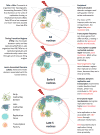Complex correlations: replication timing and mutational landscapes during cancer and genome evolution
- PMID: 24598232
- PMCID: PMC4140690
- DOI: 10.1016/j.gde.2013.11.022
Complex correlations: replication timing and mutational landscapes during cancer and genome evolution
Abstract
A recent flurry of reports correlates replication timing (RT) with mutation rates during both evolution and cancer. Specifically, point mutations and copy number losses correlate with late replication, while copy number gains and other rearrangements correlate with early replication. In some cases, plausible mechanisms have been proposed. Point mutation rates may reflect temporal variation in repair mechanisms. Transcription-induced double-strand breaks are expected to occur in transcriptionally active early replicating chromatin. Fusion partners are generally in close proximity, and chromatin in close proximity replicates at similar times. However, temporal enrichment of copy number gains and losses remains an enigma. Moreover, many conclusions are compromised by a lack of matched RT and sequence datasets, the filtering out of developmental variation in RT, and the use of somatic cell lines to make inferences about germline evolution.
Copyright © 2014 Elsevier Ltd. All rights reserved.
Figures

Similar articles
-
DNA replication timing and long-range DNA interactions predict mutational landscapes of cancer genomes.Nat Biotechnol. 2011 Nov 20;29(12):1103-8. doi: 10.1038/nbt.2030. Nat Biotechnol. 2011. PMID: 22101487 Free PMC article.
-
Cancer Mutational Processes Vary in Their Association with Replication Timing and Chromatin Accessibility.Cancer Res. 2021 Dec 15;81(24):6106-6116. doi: 10.1158/0008-5472.CAN-21-2039. Epub 2021 Oct 26. Cancer Res. 2021. PMID: 34702725
-
Breakpoint profiling of 64 cancer genomes reveals numerous complex rearrangements spawned by homology-independent mechanisms.Genome Res. 2013 May;23(5):762-76. doi: 10.1101/gr.143677.112. Epub 2013 Feb 14. Genome Res. 2013. PMID: 23410887 Free PMC article.
-
Break-induced replication: functions and molecular mechanism.Curr Opin Genet Dev. 2013 Jun;23(3):271-9. doi: 10.1016/j.gde.2013.05.007. Epub 2013 Jun 18. Curr Opin Genet Dev. 2013. PMID: 23790415 Free PMC article. Review.
-
Scales and mechanisms of somatic mutation rate variation across the human genome.DNA Repair (Amst). 2019 Sep;81:102647. doi: 10.1016/j.dnarep.2019.102647. Epub 2019 Jul 8. DNA Repair (Amst). 2019. PMID: 31307927 Review.
Cited by
-
Integrative detection and analysis of structural variation in cancer genomes.Nat Genet. 2018 Oct;50(10):1388-1398. doi: 10.1038/s41588-018-0195-8. Epub 2018 Sep 10. Nat Genet. 2018. PMID: 30202056 Free PMC article.
-
*K-means and cluster models for cancer signatures.Biomol Detect Quantif. 2017 Aug 2;13:7-31. doi: 10.1016/j.bdq.2017.07.001. eCollection 2017 Sep. Biomol Detect Quantif. 2017. PMID: 29021969 Free PMC article.
-
Rif1-Dependent Control of Replication Timing.Genes (Basel). 2022 Mar 20;13(3):550. doi: 10.3390/genes13030550. Genes (Basel). 2022. PMID: 35328102 Free PMC article. Review.
-
Regulation of DNA Replication Initiation by Chromosome Structure.J Bacteriol. 2015 Nov;197(21):3370-7. doi: 10.1128/JB.00446-15. Epub 2015 Aug 17. J Bacteriol. 2015. PMID: 26283772 Free PMC article. Review.
-
Endogenous DNA Damage as a Source of Genomic Instability in Cancer.Cell. 2017 Feb 9;168(4):644-656. doi: 10.1016/j.cell.2017.01.002. Cell. 2017. PMID: 28187286 Free PMC article. Review.
References
Publication types
MeSH terms
Grants and funding
LinkOut - more resources
Full Text Sources
Other Literature Sources
Miscellaneous

